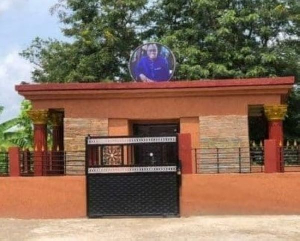On this day 27 April 1993 (Exactly 27 years ago today) The DHC-5 Buffalo transport aircraft of the Zambian Air Force crashed into the Atlantic Ocean shortly after taking off from Libreville, Gabon.
The flight was carrying most of the Zambian national football team to a FIFA World Cup Qualifier against Senegal in Dakar. All 25 passengers and five crew members were killed. The official investigation concluded that the pilot had shut down the wrong engine following an engine fire. It also found that pilot fatigue and a faulty instrument had contributed to the accident.
Accident
The flight had been specially arranged by the Zambian Air Force for the football team. The journey was scheduled to make three refueling stops; the first at Brazzaville, Congo, the second at Libreville, Gabon, and the third at Abidjan, Ivory Coast.
At the first stop in Brazzaville engine problems were noted. Despite this, the flight continued and a few minutes after taking off from the second stop in Libreville the left engine caught fire and failed.
The pilot, who had also flown the team from a match in Mauritius the previous day, then shut down the right engine, causing the plane to lose all power during the climb out of Libreville Airport and fall into the water 500 m (550 yd) offshore.
A Gabonese report released in 2003 attributed the pilot’s actions to a faulty warning light and fatigue on the part of the pilot.
Aircraft
The aircraft entered service in 1975. The plane had been out of service for five months from late 1992 until 21 April 1993. Test flights were carried out on 22 and 26 April. Prior to the departure for Senegal, checks revealed a number of defects in the engine: carbon particles in oil filters, disconnected cables and trace of heating. However, the flight went ahead as scheduled
Passengers
The Chipolopolo were a very promising Zambia national team. At the 1988 Olympic Games in Seoul they thrashed Italy 4–0. They had their eyes on the 1994 Africa Cup of Nations trophy and a place at their first World Cup.
All 30 passengers and crew, including 18 players, as well as the national team coach and support staff, died in the accident. The Chipolopolo’s captain, Kalusha Bwalya—later national team coach and president of the Football Association of Zambia (FAZ)—was not aboard the flight as he was in the Netherlands playing for PSV at that time and had made separate arrangements to make his own way to Senegal to take part in the match.
Charles Musonda, at the time playing in Belgium for Anderlecht, was previously injured and thus was not on the flight. Bennett Mulwanda Simfukwe, who had been seconded to the FAZ by his employers (ZCCM) for 5 years and was supposed to be on this flight, wasn’t on the flight because his employers demanded that he should immediately be removed from the list of those who were officially scheduled to travel to Senegal.
Investigation
A campaign to have the Gabonese crash investigation publicly released continued into the 2000s. In November 2003 a preliminary crash investigation report was released by the Gabonese government. Despite this relatives of the victims continue to lobby the Zambian government to produce a report on how the aircraft was allowed to leave Zambia.
Aftermath
The members of the national team killed in the crash were buried in what became known as “Heroes’ Acre”, just outside the Independence Stadium in Lusaka.
A new side was quickly assembled, and led by Bwalya, faced up to the difficult task of having to complete Zambia’s World Cup qualifiers and then prepare for the upcoming African Nations Cup which was only months away.
The resurrected team defied the odds, and displaying an attacking playing style, reached the final against Nigeria. They took the lead in the first half, but the Super Eagles quickly equalised and followed up with the winner in the second half. In spite of the loss, the Zambian side returned home as national heroes
In 2012, Zambia won the Africa Cup of Nations in Libreville, only a few hundred metres inland from the crash site; the victory was dedicated to the ones who lost their lives in the tragedy. Zambia beat Côte d’Ivoire 8–7 in a penalty shoot out after the game ended 0–0 after normal and added time.
The accident was the subject of the 2014 Spanish/Zambian documentary film Eighteam, directed by Juan Rodriguez-Briso
Victims
All thirty people on-board died in the crash.
Crew
Colonel Fenton Mone (pilot)
Lt Colonel Victor Mubanga (pilot)
Lt Colonel James Sachika (pilot)
Major Edward Nhamboteh (Flight Engineer)
Footballers
Efford Chabala (goalkeeper)
John Soko (defender)
Whiteson Changwe (defender)
Robert Watiyakeni (defender)
Eston Mulenga (defender)
Derby Makinka (midfielder)
Moses Chikwalakwala (midfielder)
Wisdom Mumba Chansa (midfielder)
Kelvin “Malaza” Mutale (striker)
Timothy Mwitwa (striker)
Numba Mwila (midfielder)
Richard Mwanza (goalkeeper)
Samuel Chomba (defender)
Moses Masuwa (striker)
Kenan Simambe (striker)
Godfrey Kangwa (midfielder)
Winter Mumba (defender)
Patrick “Bomber” Banda (striker
Coaching staff
Godfrey “Ucar” Chitalu (coach)
Alex Chola (assistant coach)
Sports News of Monday, 27 April 2020
Source: happyghana.com
Today in Sports History: Zambian national football team killed in a plane crash
Entertainment












